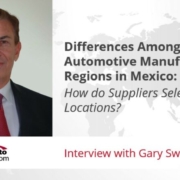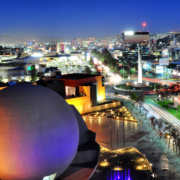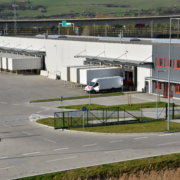A large skills gap plagues the modern business world: the skills possessed by prospective employees versus those required to perform the job effectively. One of the best examples of this is in the manufacturing industry. Currently, there are a number of positions available in manufacturing, and employers are scrambling to fill them, but they are unable to locate qualified candidates with the proper skill set. By 2030, the National Association of Manufacturers anticipates 2.1 million unfilled manufacturing jobs in the United States due to a shortage of qualified manufacturing workers.
There is good news, however, for manufacturing companies who may be concerned they will not be able to find the right type of workers to produce their products: manufacturing in Mexico is a viable option. Despite its large, skilled, and educated workforce, Mexico is largely underutilized as a source of manufacturing workers.
How can leveraging the labor pool in Mexico help address the manufacturing skills gap in the U.S.?
Finding The Right Workers
It is becoming increasingly difficult to find skilled workers for manufacturing jobs in the United States. Compared to 20 years ago, the number of Americans employed in manufacturing has decreased by approximately 5 million. In spite of a near record number of job openings in the manufacturing sector, 63% of the jobs lost during the pandemic have not been recovered by the end of 2020.
What are the reasons that so many people are choosing not to pursue jobs in the manufacturing industry? There are actually several reasons for this:
- People Are Retiring: In the manufacturing sector, the average employee is 44 years old, and older employees are retiring at a faster rate than they are being replaced. In the United States, a baby boomer retires every eight seconds, according to Carolyn Lee, the National Association of Manufacturers’ director of workforce development.
- New Skills for Manufacturing Are Not Being Taught: There are no sufficient training programs for workers to bring their skills to the open positions in the manufacturing sector, which is increasingly characterized by high-tech and high-skill jobs. In order to meet the needs of manufacturers, multi-functional engineering technicians possessing both traditional manufacturing skills as well as engineering skills are required. Developing strong, localized talent pipelines with education partners in the community is imperative for manufacturers in order to locate workers with the necessary specialized skills.
- Outdated Perception of Manufacturing Careers: Employers also point to another problem contributing to the industry’s labor shortage: an outdated perception of what manufacturing jobs entail. “Many people, they still think it’s like dark, dirty, dingy,” says Diana Peters, executive director of Symbol Training Institute. Paul Wellener, Deloitte vice chairman and U.S. industrial products and construction leader, adds: “Attracting and retaining diverse talent presents both a challenge and a solution to bridging the talent gap. To attract a new generation of workers, the industry should work together to change the perception of work in manufacturing and expand and diversify its talent pipeline.”
- People Are Quitting: According to the Washington Post, an increase of nearly 60 percent in worker resignations has been reported in manufacturing since the outbreak of the pandemic. People cited lack of control over their schedules, meager raises and pay scales, and having to work during the pandemic as reasons for leaving.
What Happens When There Is A Shortage Of Skilled Workers?
As a result of a shortage of skilled manufacturing workers, manufacturing businesses have been unable to grow and the economy has not recovered fully from the 2020 pandemic. The National Association of Manufacturers states: “Manufacturers surveyed reported that finding the right talent is now 36% harder than it was in 2018, even though the unemployment rate has nearly doubled the supply of available workers.”
As a result of the shortage of workers in the labor pool, companies are also experiencing other related issues. A number of factors undermine manufacturers’ ability to compete, including hiring ill-suited candidates, forgone production opportunities, reduced business investment, and fewer product development opportunities.
Due to fierce competition for skilled workers and the possibility that they might demand a high price for their services, companies might take shortcuts elsewhere in their operations in order to save money and increase profits. According to Alibaba:
“However, cutting costs during production is often easier said than done. You want to ensure you’re not compromising the quality of your products on your cost-cutting mission, while finding ways to sustainably reduce your production costs. How do you navigate the complexities of this situation?”
Last but not least, employees with insufficient skills can affect the quality of their work. As a result, manufacturing companies will incur higher costs when redoing faulty work or having to compensate third parties as a result of negligence on the part of employees that are not properly trained or skilled.
As stated by DB&T: “Ongoing labor challenges could also impede U.S. manufacturing companies’ ability to expand or invest in emerging technologies that improve productivity rates and workplace safety—exacerbating the cycle.”
Mexico Can Help Fill The Skills Gap Void
Beyond the southern border of the United States may be a solution to the problem of finding workers for manufacturing companies. The skilled labor pool in Mexico, a longstanding trading and manufacturing partner of the US, can assist American manufacturing companies in filling the gaps in their current production processes.As a key component of economic growth and development, international labor has historically been a valuable resource for employers in need of labor. Workers in other companies, such as Mexico, can be used by manufacturers to supplement their existing workforce and fill the skills gap, both for high-level professionals and skilled workers. In addition, the USMCA treaty makes it even easier for US companies to access this source of skilled labor in Mexico.
According to Baker/Tilley:
“Mexico enjoys a low unemployment rate, a highly educated workforce with multiple generations of manufacturing experience, and an economically active demographic with a median age of 30 years. Today, Mexico is second only behind Canada among countries with the largest percentage of employment per capita in creative industries. Mexico also graduates more engineers per capita on an annual basis than the United States. In the manufacturing sector, the average wage is about $2 an hour in Mexico, vs. about $20 per hour in the U.S. This pool of skilled workers in Mexico is a benefit for foreign companies looking to reduce labor costs but keep a high level of quality standards for their products.”
There is no doubt that the manufacturing jobs of today are radically different from those of 20 years ago. Nowadays, they are more and more high-tech. There is a great need for workers who are capable of designing and manufacturing products using computer-controlled machinery and simultaneously finding ways to increase efficiency.
Indeed reports that these sought-after skills are most commonly found in the automotive, aerospace, and defense sectors, which are heavily reliant on electronics and require a detailed understanding of the final product. Furthermore, they are often associated with very complex assembly procedures.
Manufacturing workers in Mexico possess these skills in abundance, particularly in the automotive industry. In 2020, Mexico’s automotive industry accounted for 41.6% of total manufactured exports ($139.8 billion), the highest share among all industrial sectors. With the variety of industries related to automobiles, the Mexican Automotive Industry Association estimates that Mexico will become the fifth-largest worldwide vehicle producer of all types, not just passenger vehicles, by 2025. Manufacturing of automotive wiring harnesses, distributors, and ignition systems is the primary activity of the automotive electronics manufacturing industry in Mexico.
Outside of the automotive industry, electronics manufacturing and assembly is also a major industry in Mexico. Because of the expertise of Maquiladoras, electronic component manufacturing, such as circuit boards, wire harnesses, computers, and consumer electronics, is one of Mexico’s fastest growing industries. Those seeking alternatives to their manufacturing operations in China are finding that Mexico’s contract manufacturing partners are able to provide electronic components that are as good, if not better, than those produced in China.
If you do not want to send your manufacturing to Mexico, there is still a way to utilize the labor pool in Mexico in the U.S., even if you do not want to send your production abroad. Using a “TN Visa” you may bring skilled workers from Mexico to the U.S. to fill in your shortage of skilled workers. As part of the North American Free Trade Agreement (NAFTA), the TN visa was established to allow certain Canadians and Mexicans to work temporarily in the United States. Former President Donald Trump implemented the United States-Mexico-Canada Agreement (USMCA), while keeping the provisions of NAFTA regarding work visas intact.
The TN visa is available to professionals in manufacturing fields, such as industrial engineers, industrial designers, and other consulting roles, provided they meet the appropriate criteria for entry into the United States.
Source: Ivannovation










